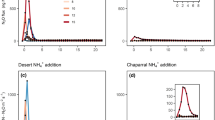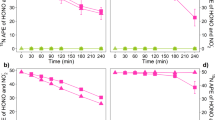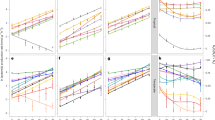Abstract
Nitrogen (N) trace gas emission pulses produced after wetting dry soils may be important pathways of ecosystem N loss. However, the rates and mechanisms controlling these emissions remain unclear. We tested whether changes in microbial community structure and increased rates of atmospheric N deposition could explain N emissions at two desert sites differing in atmospheric N deposition by ~ six fold. We measured peak NOx (sum of nitric oxide and nitrogen dioxide) emissions 12 h post-wetting. NOx emissions remained elevated over 24 h and increased after adding N. In contrast, we measured the highest nitrous oxide (N2O) emissions within only 15 min post-wetting. N2O emissions decreased within 12 h, were insensitive to adding N, and were among the highest reported globally. Microbial communities at the high N deposition site were less diverse with higher 16S nitrifier and bacterial amoA gene abundances relative to the low N deposition site, suggesting an increased capacity for nitrification. Nevertheless, N emissions were lower at the high N deposition site. While microbial communities changed after wetting, these changes were not correlated with N emissions. We conclude that desert soils can produce substantial NOx and N2O emission pulses, but that these emissions do not appear directly governed by changing microbial community characteristics or higher atmospheric N inputs. These findings highlight the importance of gaseous N loss pathways from dryland ecosystems that may contribute to sustained N limitation, with implications for atmospheric chemistry and Earth’s climate.


Similar content being viewed by others
References
Aronson EL, Goulden ML, Allison SD (2019) Greenhouse gas fluxes under drought and nitrogen addition in a Southern California grassland. Soil Biol Biochem 131:19–27
Beman JM, Popp BN, Francis CA (2008) Molecular and biogeochemical evidence for ammonia oxidation by marine Crenarchaeota in the Gulf of California. ISME J 2:429–441
Bier RL et al (2015) Linking microbial community structure and microbial processes: an empirical and conceptual overview. FEMS Microbiol Ecol. https://doi.org/10.1093/femsec/fiv113
Blagodatskaya E, Kuzyakov Y (2013) Active microorganisms in soil: Critical review of estimation criteria and approaches. Soil Biol Biochem 67:192–211
Bokulich NA, Subramanian S, Faith JJ, Gevers D, Gordon JI, Knight R, Mills DA, Caporaso JG (2013) Quality-filtering vastly improves diversity estimates from Illumina amplicon sequencing. Nat Methods 10:57–U11
Caporaso JG, Kuczynski J, Stombaugh J, Bittinger K, Bushman FD, Costello EK et al (2010) QIIME allows analysis of high-throughput community sequencing data. Nat Methods 7:335–336
Carey CJ, Dove NC, Beman JM, Hart SC, Aronson EL (2016) Meta-analysis reveals ammonia-oxidizing bacteria respond more strongly to nitrogen addition than ammonia-oxidizing archaea. Soil Biol Biochem 99:158–166
Conrad R (1996) Soil microorganisms as controllers of atmospheric trace gases (H-2, CO, CH4, OCS, N2O, and NO). Microbiol Rev 60:609–640
Cowan NJ, Norman P, Famulari D, Levy PE, Reay DS, Skiba UM (2015) Spatial variability and hotspots of soil N2O fluxes from intensively grazed grassland. Biogeosciences 12:1585–1596
Crutzen PJ (1979) Role of NO and NO2 in the Chemistry of the Troposphere and Stratosphere. Annu Rev Earth Pl Sc 7:443–472
Davidson EA, Vitousek PM, Matson PA, Riley R, Garciamendez G, Maass JM (1991) Soil emissions of nitric-oxide in a seasonally dry tropical forest of Mexico. Journal of Geophysical Research-Atmospheres 96:15439–15445
Davidson EA, Keller M, Erickson HE, Verchot LV, Veldkamp E (2000) Testing a conceptual model of soil emissions of nitrous and nitric oxides. Bioscience 50:667–680
Edgar RC (2010) Search and clustering orders of magnitude faster than BLAST. Bioinformatics 26:2460–2461
Fenn ME, Poth MA, Aber JD, Baron JS, Bormann BT, Johnson DW, Lemly AD, McNulty SG, Ryan DE, Stottlemyer R (1998) Nitrogen excess in North American ecosystems: Predisposing factors, ecosystem responses, and management strategies. Ecol Appl 8:706–733
Fenn ME et al (2003) Nitrogen emissions, deposition, and monitoring in the western United States. Bioscience 53:391–403
Fenn ME, Jovan S, Yuan F, Geiser L, Meixner T, Gimeno BS (2008) Empirical and simulated critical loads for nitrogen deposition in Californiamixed conifer forests. Environ Pollut 155:492–511
Fenn ME, Poth MA (2004) Monitoring nitrogen deposition in throughfall using ion exchange resin columns: A field test in the San Bernardino Mountains. J Environ Qual 33:2007–2014
Fierer N, Jackson RB (2006) The diversity and biogeography of soil bacterial communities. Proc Natl Acad Sci USA 103:626–631
Graham EB et al (2016) Microbes as Engines of Ecosystem Function: When Does Community Structure Enhance Predictions of Ecosystem Processes? Frontiers in Microbiology. https://doi.org/10.3389/fmicb.2016.00214
Gu XY, Wang YH, Laanbroek HJ, Xu XF, Song B, Huo YW, Chen SP, Li LH, Zhang LH (2019) Saturated N2O emission rates occur above the nitrogen deposition level predicted for the semi-arid grasslands of Inner Mongolia, China. Geoderma 341:18–25
Hall SJ, Matson PA (2003) Nutrient status of tropical rain forests influences soil N dynamics after N additions. Ecol Monogr 73:107–129
Hall SJ, Huber D, Grimm NB (2008) Soil N2O and NO emissions from an arid, urban ecosystem. Journal of Geophysical Research-Biogeosciences. https://doi.org/10.1029/2007jg000523
Hall SJ, Silver WL, Amundson R (2012) Greenhouse gas fluxes from Atacama Desert soils: a test of biogeochemical potential at the Earth's arid extreme. Biogeochemistry 111:303–315
Hall EK et al (2018) Understanding how microbiomes influence the systems they inhabit. Nature Microbiology 3:977–982
Hartley AE, Schlesinger WH (2000) Environmental controls on nitric oxide emissions from northern Chihuahuan desert soils. Biogeochemistry 50:279–300
Hayatsu M, Tago K, Saito M (2008) Various players in the nitrogen cycle: Diversity and functions of the microorganisms involved in nitrification and denitrification. Soil Science and Plant Nutrition 54:33–45
Heil J, Vereecken H, Bruggemann N (2016) A review of chemical reactions of nitrification intermediates and their role in nitrogen cycling and nitrogen trace gas formation in soil. Eur J Soil Sci 67:23–39
Holtgrieve GW, Jewett PK, Matson PA (2006) Variations in soil N cycling and trace gas emissions in wet tropical forests. Oecologia 146:584–594
Homyak PM, Sickman JO (2014) Influence of soil moisture on the seasonality of nitric oxide emissions from chaparral soils, Sierra Nevada, California, USA. J Arid Environ 103:46–52
Homyak PM, Blankinship JC, Marchus K, Lucero DM, Sickman JO, Schimel JP (2016) Aridity and plant uptake interact to make dryland soils hotspots for nitric oxide (NO) emissions. Proc Natl Acad Sci USA 113:E2608–E2616
Homyak PM, Kamiyama M, Sickman JO, Schimel JP (2017) Acidity and organic matter promote abiotic nitric oxide production in drying soils. Glob Change Biol 23:1735–1747
Jenerette GD, Chatterjee A (2012) Soil metabolic pulses: water, substrate, and biological regulation. Ecology 93:959–966
Klindworth A, Pruesse E, Schweer T, Peplies J, Quast C, Horn M, Glockner FO (2013) Evaluation of general 16S ribosomal RNA gene PCR primers for classical and next-generation sequencing-based diversity studies. Nucleic Acids Res. https://doi.org/10.1093/nar/gks808
Leininger S, Urich T, Schloter M, Schwark L, Qi J, Nicol GW, Prosser JI, Schuster SC, Schleper C (2006) Archaea predominate among ammonia oxidizing prokaryotes in soils. Nature. https://doi.org/10.1038/nature04983
Leitner S, Homyak PM, Blankinship JC, Eberwein J, Jenerette GD, Zechmeister-Boltenstern S, Schimel JP (2017) Linking NO and N2O emission pulses with the mobilization of mineral and organic N upon rewetting dry soils. Soil Biol Biochem 115:461–466
Lennon JT, Jones SE (2011) Microbial seed banks: the ecological and evolutionary implications of dormancy. Nat Rev Microbiol 9:119–130
Lennon JT, Muscarella ME, Placella SA, Lehmkuhl BK (2018) How, when, and where relic DNA affects microbial diversity. mBio 9:e00637–e718. https://doi.org/10.1128/mBio.00637-18
Li YY, Chapman SJ, Nicol GW, Yao HY (2018) Nitrification and nitrifiers in acidic soils. Soil Biol Biochem 116:290–301
Liu S et al (2017) Abiotic conversion of extracellular NH2OH contributes to N2O emission during ammonia oxidation. Environ Sci Technol 51:13122–13132
Lozupone C, Knight R (2005) UniFrac: a new phylogenetic method for comparing microbial communities. Appl Environ Microbiol 71:8228–8235
Marusenko, Y., F. Garcia-Pichel, S.J. Hall. (2015) Ammonia-oxidizing archaea respond positively to inorganic nitrogen addition in desert soils, FEMS Microbiology Ecology 1–11.
McArdle BH, Anderson MJ (2001) Fitting multivariate models to community data: A comment on distance-based redundancy analysis. Ecology 82:290–297
McDonald D, Price MN, Goodrich J, Nawrocki EP, DeSantis TZ, Probst A, Andersen GL, Knight R, Hugenholtz P (2012) An improved Greengenes taxonomy with explicit ranks for ecological and evolutionary analyses of bacteria and archaea. ISME J 6:610–618
Meixner FX, Yang WX (2006) Biogenic emissions of nitric oxide and nitrous oxide from arid and semi-arid land. In: D'Odorico P, Porporato A (eds) Dryland Ecohydrology. Springer, Netherlands, Dordrecht, pp 233–255
Mushinski RM, Phillips RP, Payne ZC, Abney RB, Jo I, Fei SL, Pusede SE, White JR, Rusch DB, Raff JD (2019) Microbialmechanisms and ecosystem flux estimation for aerobic NOy emissions from deciduous forest soils. Proc Nat Acad Sci USA 116:2138–2145
Niboyet A, Brown JR, Dijkstra P, Blankinship JC, Leadley PW, Le Roux X, Barthes L, Barnard RL, Field CB, Hungate BA (2011) Global Change Could Amplify Fire Effects on Soil Greenhouse Gas Emissions. PLoS ONE. https://doi.org/10.1371/journal.pone.0020105
Oerter E, Mills JV, Maurer GE, Lammers LN, Amundson R (2018) Greenhouse gas production and transport in desert soils of the southwestern United States. Global Biogeochem Cycles 32:1703–1717
Oikawa PY, Ge C, Wang J, Eberwein JR, Liang LL, Allsman LA, Grantz DA, Jenerette GD (2015) Unusually high soil nitrogen oxide emissions influence air quality in a high-temperature agricultural region. Nature Communications. https://doi.org/10.1038/ncomms9753
Peterjohn WT, Schlesinger WH (1990) Nitrogen loss from deserts in the Southwestern United-States. Biogeochemistry 10:67–79
Peterjohn WT, Schlesinger WH (1991) Factors controlling denitrification in a Chihuahuan desert ecosystem. Soil Sci Soc Am J 55:1694–1701
Philippot L, Spor A, Henault C, Bru D, Bizouard F, Jones CM, Sarr A, Maron PA (2013) Loss in microbial diversity affects nitrogen cycling insoil. ISME Jl 7:1609–1619
Placella SA, Brodie EL, Firestone MK (2012) Rainfall-induced carbon dioxide pulses result from sequential resuscitation of phylogenetically clustered microbial groups. Proc Natl Acad Sci USA 109:10931–10936
Prosser JI, Nicol GW (2012) Archaeal and bacterial ammonia-oxidisers in soil: the quest for niche specialisation and differentiation. Trends Microbiol 20:523–531
Price MN, Dehal PS, Arkin AP (2009) FastTree: Computing Large Minimum Evolution Trees with Profiles instead of a Distance Matrix. Mol Biol Evol 26:1641–1650
R Development Core Team (2015) R: a language and environment for statistical computing. R Foundation for Statistical Computing, Vienna
Rao LE, Allen EB (2010) Combined effects of precipitation and nitrogen deposition on native and invasive winter annual production in California deserts. Oecologia 162:1035–1046
Ravishankara AR, Daniel JS, Portmann RW (2009) Nitrous oxide (N2O): the dominant ozone-depleting substance emitted in the 21st century. Science 326(5949):123–125
Rotthauwe JH, Witzel KP, Liesack W (1997) The ammonia monooxygenase structural gene amoA as a functional marker: Molecular fine-scale analysis of natural ammonia-oxidizing populations. Appl Environ Microbiol 63:4704–4712
Schimel JP, Gulledge J (1998) Microbial community structure and global trace gases. Glob Change Biol 4:745–758
Shade A, Peter H, Allison SD, Baho DL, Berga M, Bürgmann H, Huber DH, Langenheder S, Lennon JT, Martiny JBH, Matulich KL, Schmidt TM, Handelsman J (2012) Fundamentals of microbial community resistance and resilience. Frontiers in Microbiology 3:417–417
Soper FM, Boutton TW, Groffman PM, Sparks JP (2016) Nitrogen trace gas fluxes from a semiarid subtropical savanna under woody legume encroachment. Global Biogeochem Cycles 30:614–628. https://doi.org/10.1002/2015GB005298
Soper FM, Sullivan BW, Osborne BB, Shaw AN, Philippot L, Cleveland CC (2019) Leaf-cutter ants engineer large nitrous oxide hot spots in tropical forests. Proceedings of the Royal Society B: Biological Sciences 286:20182504
Smith KA, Clayton H, Arah JRM, Christensen S, Ambus P, Fowler D, Hargreaves KJ, Skiba U, Harris GW, Wienhold FG, Klemedtsson L, Galle B (1994) Micrometeorological and chamber methods for measurement of nitrous-oxide fluxes between soils and the atmosphere – an overview and conclusions. J Geophys Res-Atmos 99:16541–16548
Šťoviček A, Azatyan A, Soares MIM, Gillor O (2017) The Impact of Hydration and Temperature on Bacterial Diversity in Arid Soil Mesocosms. Frontiers in Microbiology. https://doi.org/10.3389/fmicb.2017.01078
Teh YA, Silver WL, Sonnentag O, Detto M, Kelly M, Baldocchi DD (2011) large greenhouse gas emissions from a temperate peatland pasture. Ecosystems 14:311–325
Townsend-Small A, Czimczik CI (2010) Carbon sequestration and greenhouse gas emissions in urban turf. Geophys Res Lett. https://doi.org/10.01029/02009gl041675
Vitousek PM, Aber JD, Howarth RW, Likens GE, Matson PA, Schindler DW, Schlesinger WH, Tilman DG (1997) Human alteration of the global nitrogen cycle: Sources and consequences. Ecol Appl 7:737–750
Vourlitis GL, DeFotis C, Kristan W (2015) Effects of soil water content, temperature and experimental nitrogen deposition on nitric oxide (NO) efflux from semiarid shrubland soil. J Arid Environ 117:67–74
von Sperber C, Chadwick OA, Casciotti KL, Peay KG, Francis CA, Kim AE, Vitousek PM (2017) Controls of nitrogen cycling evaluated along a well-characterized climate gradient. Ecology 98:1117–1129
Wang B, Lerdau M, He YL (2017) Widespread production of nonmicrobial greenhouse gases in soils. Glob Change Biol 23:4472–4482
Wang C, Liu D, Bai E (2018) Decreasing soil microbial diversity is associated with decreasing microbial biomass under nitrogen addition. Soil Biol Biochem 120:126–133
Ying JY, Li XX, Wang NN, Lan ZC, He JZ, Bai YF (2017) Contrasting effects of nitrogen forms and soil pH on ammonia oxidizing microorganisms and their responses to long-term nitrogen fertilization in a typical steppe ecosystem. Soil Biol Biochem 107:10–18
Zeng J, Liu XJ, Song L, Lin XG, Zhang HY, Shen CC, Chu HY (2016) Nitrogen fertilization directly affects soil bacterial diversity and indirectly affects bacterial community composition. Soil Biol Biochem 92:41–49
Zhang LM, Hu HW, Shen JP, He JZ (2012) Ammonia-oxidizing archaea have more important role than ammonia-oxidizing bacteria in ammonia oxidation of strongly acidic soils. ISME J 6:1032–1045
Acknowledgements
We are thankful to Elizah Stephens and Johan Püspök for their suggestions on early versions of this manuscript. We thank the National Science Foundation (DEB 1405525, 1656062, and 1916622), Environmental Protection Agency STAR Graduate Fellowship, Ford Foundation, USDA NIFA CA-R-PPA-5101-CG and NIFA Hatch CA-R-PPA-5093-H, and the University of California Natural Reserve System (https://doi.org/10.21973/N3V66D) for their support.
Author information
Authors and Affiliations
Corresponding author
Additional information
Responsible Editor: Kate Lajtha.
Publisher's Note
Springer Nature remains neutral with regard to jurisdictional claims in published maps and institutional affiliations.
Electronic supplementary material
Below is the link to the electronic supplementary material.
Rights and permissions
About this article
Cite this article
Eberwein, J.R., Homyak, P.M., Carey, C.J. et al. Large nitrogen oxide emission pulses from desert soils and associated microbiomes. Biogeochemistry 149, 239–250 (2020). https://doi.org/10.1007/s10533-020-00672-9
Received:
Accepted:
Published:
Issue Date:
DOI: https://doi.org/10.1007/s10533-020-00672-9




